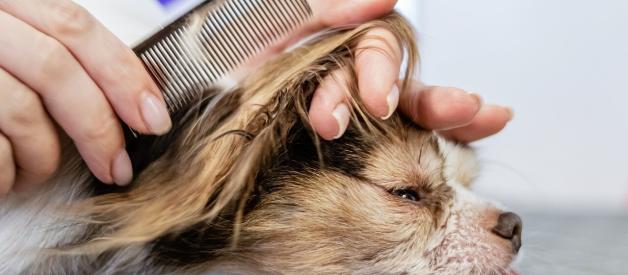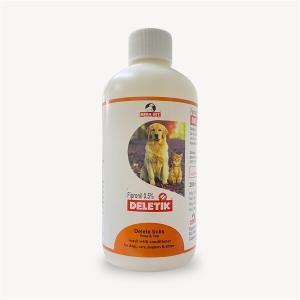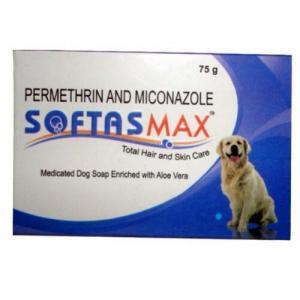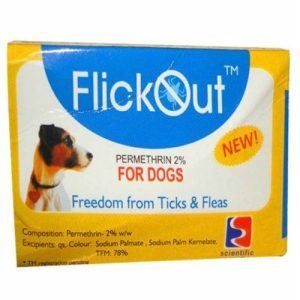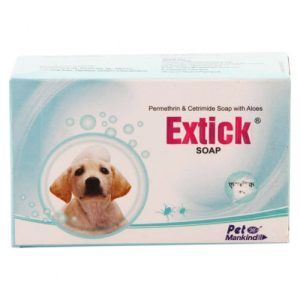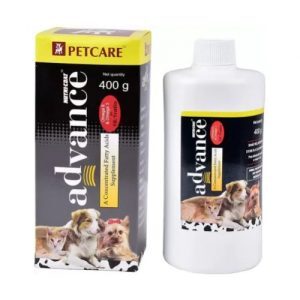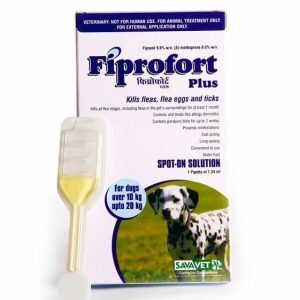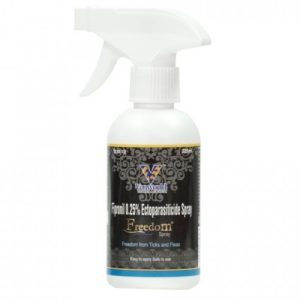Table of Contents
Ticks and fleas harm dogs as they can cause irritation, skin problems, and anemia and transmit diseases from fleas in dogs, posing severe health risks to the animals. It is essential to treat your dog for ticks and fleas regularly. Preventive measures are also necessary to protect your pet’s well-being. Regular treatment can help prevent infestations, reduce the risk of diseases, and ensure your dog leads a comfortable and healthy life.

How to Get Rid of Ticks and Fleas in Dogs
So, how to kill fleas and ticks in dogs?
Getting rid of ticks and fleas in dogs involves a combination of preventive measures and treatment options. Here’s a step-by-step guide on how to effectively manage these pests:
- Regular grooming: Regularly groom your dog using a fine-toothed flea comb. This can help you identify and remove adult fleas and ticks from your dog’s coat. Do fleas cause hair loss in dogs? Yes, sometimes it can happen. Grooming and special products for dogs’ coat may help.
- Bathing: Bath your dog using a mild dog shampoo that contains flea and tick-repelling ingredients. This can help drown and wash away some of the parasites.
- Tick removal: If you find ticks on your dog, use fine-tipped tweezers to carefully grasp the tick as close to the skin’s surface as possible. Gently pull upward with steady pressure to remove the entire tick. Avoid squeezing or twisting the tick, as this can cause parts of the tick to break off and remain in the skin.
- Flea treatment: Use veterinarian-recommended flea control products such as spot-on treatments, oral medications, or flea collars. These products can help kill adult fleas and disrupt their life cycle.
- Tick prevention: Use tick preventive products, such as spot-on treatments or collars, to protect your dog from tick infestations. These products can help repel ticks and prevent them from attaching to your dog.
- Environmental control: How to kill fleas in dog bedding?Clean and vacuum your home regularly, paying special attention to areas where your dog spends time. Wash your dog’s bedding and toys frequently in hot water to kill fleas and ticks.
- Yard maintenance: Keep your yard well-maintained by mowing the grass regularly and removing tall weeds and shrubs where ticks may reside. Consider using environmentally safe tick repellents in your yard.
- Consult your veterinarian: If your dog has a severe infestation or is showing flea allergy dermatitis symptoms, consult your veterinarian. They can advise how to treat flea allergy dermatitis in dogs, the best treatment options, and advice on managing tick and flea issues.
Remember that prevention is key in managing ticks and fleas in dogs. Regularly using preventive products and maintaining good hygiene for your dog and living environment can significantly reduce the risk of infestations and related health problems. If you are interested in how long it takes to get rid of fleas in a dog, ask your veterinarian.
What Can I Put in My Dog’s Bath to Remove Fleas?
Using special ticks and fleas products for bathing dogs is important because these products are formulated with ingredients that effectively kill and repel ticks and fleas, providing better protection for your pet’s health. Veterinarians suggest Deletik Shampoo.
Deletik (Fipronil) Shampoo 0,5% 200ml
Deletik Shampoo contains the active ingredient Fipronil, which treats and prevents tick and flea infestations in dogs. Fipronil is an insecticide that targets the nervous system of ticks and fleas, effectively killing them upon contact. How often can I bathe my dog in flea shampoo? Deletik Shampoo can be used as needed, but it is essential to follow the manufacturer’s instructions and consult your vet to determine the most appropriate and safe usage for your dog’s specific needs.
How to use Deletik Shampoo
- Wet your dog’s coat thoroughly with warm water.
- Apply the shampoo to various body parts, avoiding the eyes, ears, and mouth.
- Massage the shampoo into the coat and skin to create a lather, ensuring complete coverage.
- Leave the lather on the dog’s coat for a few minutes to allow the active ingredient to work effectively.
- Rinse the shampoo thoroughly with clean water, removing all product residues.
Benefits of using Deletik Shampoo
- Tick and flea control: Deletik Shampoo helps eliminate ticks and fleas on the dog’s skin and coat. It disrupts their life cycle and prevents reinfestations.
- Relieves itching and irritation: By removing ticks and fleas, the shampoo helps to alleviate the itching, scratching, and irritation caused by these parasites.
How to Kill Dog Fleas with the Soap
Soap for ticks and fleas is beneficial as it contains active ingredients that specifically target and eliminate these parasites, providing effective and convenient pest control during the dog’s bathing routine. We suggest the following products.
Softas Max Soap
Soap products like Softas Max Soap with Aloe Vera are commonly used for bathing dogs to clean their coat and skin. Aloe Vera is known for its soothing and moisturizing properties and is often included in pet grooming products to help maintain skin health. The active ingredient is Aloe Vera extract, derived from the Aloe Vera plant.
How to use it
- Wet your dog’s coat thoroughly with warm water.
- Rub the soap bar onto various parts of the dog’s body, creating a lather.
- Massage the lather into the dog’s coat and skin, ensuring complete coverage.
- Leave the lather on the dog’s coat for a few minutes to allow the beneficial properties of Aloe Vera to work.
- Rinse the soap thoroughly with clean water, removing all residues.
How often to use flea treatment in dogs? Considering your dog’s grooming requirements and skin condition, you can use it during regular bathing sessions as needed.
Benefits
- Gentle cleansing: The soap helps to clean your dog’s coat and skin, removing dirt and debris.
- Soothing and moisturizing: Aloe Vera is known for its soothing properties, which can help alleviate mild skin irritation and moisturize the skin.
- Aloe Vera benefits: Aloe Vera has been used in various skincare products for its potential benefits, including promoting healthy skin and aiding in healing minor skin issues.
FlickOut Soap (Permethrin) 2%, 1 mg
What is the best treatment for ticks and fleas in dogs?
FlickOut Soap is used for the control of ticks and fleas on dogs. It is formulated with active ingredients to target and eliminate these parasites. The active ingredient in FlickOut Soap is Permethrin, an insecticide known for its effectiveness against ticks and fleas.
How to use it
- Wet your dog’s coat thoroughly with warm water.
- Apply the soap to various parts of the dog’s body, creating a lather and focusing on areas where ticks and fleas are commonly found.
- Massage the lather into the dog’s coat and skin, ensuring complete coverage.
- Leave the lather on the dog’s coat for a few minutes to allow the active ingredient to work effectively.
- Rinse the soap thoroughly with clean water, removing all residues.
Benefits
- Tick and flea control: Permethrin effectively kills and repels ticks and fleas, reducing the infestation on the dog’s skin and coat.
- Convenient application: Soap products like FlickOut Soap offer a practical method for tick and flea control during the dog’s bathing routine.
Extick Soap (Permethrin, Cetrimide, Aloe), 75g
How to control fleas in dogs? Extick Soap is used for bathing dogs to help control ticks and fleas and maintain skin health. The combination of active ingredients, Permethrin and Cetrimide, may effectively kill and repel ticks and fleas, while Aloe Vera can provide soothing and moisturizing properties for the dog’s skin.
Active Ingredients
- Permethrin is an insecticide that targets ticks and fleas, effectively killing them upon contact.
- Cetrimide is an antiseptic agent that can help cleanse and disinfect the skin, preventing secondary infections.
- Aloe Vera is known for its soothing and moisturizing properties, which can help alleviate mild skin irritation and keep the skin hydrated.
How to use it
- Wet your dog’s coat thoroughly with warm water.
- Rub the soap bar onto various parts of the dog’s body, creating a lather.
- Massage the lather into the dog’s coat and skin, ensuring complete coverage.
- Leave the lather on the dog’s coat for a few minutes to allow the active ingredients and Aloe Vera to work.
- Rinse the soap thoroughly with clean water, removing all residues.
Considering your dog’s grooming requirements and skin condition, you can use it during regular bathing sessions or as needed for tick and flea control.
Benefits
- Tick and flea control: The combination of Permethrin and Cetrimide can help eliminate ticks and fleas on the dog’s skin and coat.
- Cleansing and disinfecting: Cetrimide can aid in cleansing the skin and preventing infections.
- Soothing and moisturizing: Aloe Vera can provide soothing properties and help keep the skin hydrated, reducing irritation and dryness.
How to Get Rid of Fleas in Dogs Naturally
What is a home remedy for flea dermatitis in dogs?
Getting rid of fleas in dogs naturally involves using non-toxic methods and natural remedies to control and eliminate these pesky parasites. Here are some natural ways to tackle flea infestations in dogs:
- Apple cider vinegar: Mix equal parts of vinegar and water in a spray bottle. Spray the solution on your dog’s coat, avoiding the eyes and any open wounds. Fleas dislike the smell and taste of apple cider vinegar.
- Diatomaceous earth: Food-grade diatomaceous earth is a natural powder that can be sprinkled on your dog’s coat and bedding. It works by dehydrating and killing fleas. Ensure to use food-grade diatomaceous earth and avoid inhalation of the powder.
- Rosemary rinses: Boil fresh rosemary leaves in water, let it steep, and then strain the liquid. After it cools down, use it as a final rinse after bathing your dog to repel fleas.
- Cedar chips or bedding: Using cedar chips or bedding in your dog’s sleeping area can help repel fleas due to the natural aromatic properties of cedar.
- Essential oils: Some essential oils, such as lavender, lemon, and eucalyptus, have natural flea-repellent properties. Dilute a few drops of the chosen oil in water and use it as a spray on your dog’s coat. Be careful with essential oils; some dogs may have sensitivities or allergies. We recommend Nutri-Coat Advance 200g, 400g.
Nutri-Coat Advance (Omega 3, Omega 6), 200g, 400g
Nutri-Coat Advance, containing Omega 3 and Omega 6 fatty acids, is likely used as a dietary supplement for dogs to support skin and coat health. The active ingredients in Nutri-Coat Advance are Omega 3 and Omega 6 fatty acids. These essential fatty acids are vital in maintaining healthy skin, promoting a glossy coat, and supporting overall well-being.
How to use it
The supplement is typically administered orally, and it may come in the form of chewable tablets, liquid, or soft gels. You can mix the supplement with your dog’s food or offer it as a treat. Generally, it is given as a daily supplement to maintain consistent support for your dog’s skin and coat health.
Benefits
- Improved skin health: Omega 3 and Omega 6 fatty acids help nourish the skin, reducing dryness and itchiness and promoting a healthy skin barrier.
- Enhanced coat appearance: These fatty acids contribute to a shiny and lustrous coat, reducing dullness and promoting overall coat health.
- Anti-inflammatory effects: Omega 3 fatty acids have anti-inflammatory properties that may help manage skin conditions and reduce skin irritation.
- Overall well-being: Omega 3 and Omega 6 fatty acids play essential roles in supporting various bodily functions, contributing to your dog’s overall health and vitality.
Best Drops to Get Rid of Ticks and Fleas in My Dog
Drops are also beneficial for getting rid of ticks and fleas in your dog as they contain active ingredients that may be applied directly to the skin, providing long-lasting protection and effectively killing and repelling parasites. Our choice is Fiprofort Plus Dog (Firpronil + Methoprene).
Fiprofort Plus Dog (Firpronil + Methoprene) 0,67ml, 1,34ml, 2,68ml, 4,02ml
Fiprofort Plus Dog is a topical spot-on treatment for dogs to control and prevent tick and flea infestations. It contains two active ingredients: Fipronil and Methoprene.
Active Ingredients
- Fipronil: Fipronil is an insecticide that effectively kills adult fleas and ticks upon contact. It disrupts the nervous system of these parasites, leading to their elimination.
- Methoprene: Methoprene is an insect growth regulator (IGR) that inhibits the development of flea eggs and larvae, preventing them from maturing into adult fleas.
How to use it
- Choose the appropriate pack size based on your dog’s weight. The different pack sizes contain varying volumes of the solution to cater to dogs of different sizes.
- Part the fur at the base of your dog’s neck to expose the skin.
- Squeeze the entire tube content directly onto the skin, applying it on one spot to avoid spreading.
- Avoid bathing your dog for at least 48 hours after application to allow the product to spread and be fully absorbed.
It is typically applied once a month for continuous protection.
Benefits
- Effective tick and flea control: The combination of Fipronil and Methoprene provides a comprehensive solution to control adult fleas, ticks, and the development of flea eggs and larvae.
- Long-lasting protection: The monthly application ensures continuous protection against fleas and ticks.
- Convenient application: The spot-on treatment is easy to apply and provides targeted coverage. If you want to know how to get rid of fleas in your dog’s ears, here is the solution. You may also want to know whether flea treatment kills ear mites in dogs. Address a veterinarian to get a consultation for your dog’s specific needs.
- Prevention of reinfestation: The product helps prevent reinfestation of fleas by targeting different stages of the flea life cycle.
Best Spray to Remove Fleas
Using a spray to remove fleas in dogs is convenient as it allows for easy and precise application, covering a larger area quickly, and can be used on dogs of various sizes and coat lengths. Freedom Spray (Fipronil) is our recommendation.
Freedom Spray (Fipronil) 0,25% 100ml
Freedom Spray (Fipronil) 0.25% 100ml is a topical solution to control and eliminate dog flea and tick infestations. The active ingredient in Freedom Spray is Fipronil, an effective insecticide that targets and kills fleas and ticks on contact.
How to use it
- Shake the bottle well before use.
- Part your dog’s fur to expose the skin, especially when fleas and ticks are commonly found in the neck, back, and between the shoulder blades.
- Hold the bottle upright and spray the solution directly onto the dog’s skin, ensuring complete coverage.
- Avoid spraying in the eyes, mouth, or open wounds.
- Use sufficient spray to thoroughly wet the fur and skin for effective results.
In most cases, it is recommended to use the spray once every four weeks for continuous protection.
Benefits
- Effective flea and tick control: The Fipronil in the spray targets and kills adult fleas and ticks upon contact, providing swift action against infestations.
- Easy application: The spray formulation allows for easy and precise application, ensuring the product reaches the affected areas.
- Long-lasting protection: The monthly application provides continuous protection against fleas and ticks.
- Versatility: The spray can be used on dogs of various sizes and coat lengths.
How to Get Rid of Fleas in Your House
What is the best way to get rid of dog fleas in the house?
Removing fleas in your house is especially important if the dog has fleas and sleeps in your bed. It can be a multi-step process. Here are some steps to eliminate fleas from your home:
Wash your pet’s bedding, blankets, and any fabric items that your pet comes into contact with in hot water. This will help kill fleas and their eggs.
Vacuum all carpets, rugs, and upholstery thoroughly, paying special attention to areas where your pet spends time. Vacuuming helps remove adult fleas, eggs, and larvae from the environment. Steam-cleaning carpets can help eliminate fleas at various life stages, including eggs and larvae. Apply a flea spray or powder specifically designed for home use to treat carpets, rugs, and furniture. Follow the product instructions carefully to ensure safe and effective application. After vacuuming, dispose of the vacuum bag in a sealed plastic bag outside your home to prevent reinfestation.
If your pet spends time outdoors, treat your yard with pet-safe flea sprays or nematodes to reduce the flea population in the environment.
Consider using flea traps with sticky pads to attract and trap adult fleas.
Use veterinarian-recommended flea treatments for your pets regularly to prevent fleas from reinfesting your home. If the infestation is severe or persists despite your efforts, consider seeking help from a professional pest control service.
Flea infestations can be challenging to eradicate completely, so consistent and thorough treatment is necessary. Be patient and persistent in getting rid of fleas in your house.
Many people ask: if my dog has fleas does that mean they are in my house? Yes, treating your pets and the environment simultaneously is essential for the best results. Removing fleas from the house, ask your veterinarian do dog fleas live on furniture or in sand and how long dog fleas can live in a house.
How to Kill Dog Fleas in the Yard
To effectively kill dog fleas in the yard, follow these steps:
- Clear debris: Remove any clutter or debris from your yard, as fleas often hide in tall grass, leaves, and other organic materials.
- Mow the lawn: Trim your lawn regularly to keep the grass short, as fleas prefer tall grass to breed and hide.
- Prune shrubs and bushes: Trim shrubs and bushes to reduce hiding spots for fleas and create a less favorable environment for them.
- Sunlight exposure: Allow sunlight to reach shady areas of the yard, as fleas prefer dark and moist spots.
- Flea treatment products: Use pet-safe flea treatment products designed for outdoor use, such as flea sprays or nematodes. Apply these treatments according to the manufacturer’s instructions.
- Flea-repellent plants: Plant natural flea-repellent plants like lavender, rosemary, and mint around your yard to deter fleas.
- Clean pet resting areas: Regularly clean and wash your pet’s resting areas, such as outdoor beds or kennels, to prevent flea infestations.
- Keep wild animals away: They can carry fleas, so try to discourage them from entering your yard using fencing or other barriers.
- Consistent treatment: Apply flea treatment products to your yard regularly and as needed to prevent fleas from returning.
- Consult a professional: If you have a severe flea infestation that persists despite your efforts, consider seeking help from a professional pest control service that offers yard treatments.
What Causes Fleas and Ticks in Dogs
How do dogs get fleas in summer?
Fleas and ticks in dogs are primarily caused by external parasites infesting the dog’s skin and fur. Here’s a brief explanation of what causes fleas and ticks in dogs:
- Fleas: Fleas are tiny, wingless insects that feed on the blood of animals, including dogs. They are highly mobile and can jump long distances, allowing them to transfer from one host to another quickly. Dogs can pick up fleas from other infested animals, such as other dogs, cats, or wildlife, and from infested environments like parks or yards.
- Ticks: Ticks are arachnids more closely related to spiders than insects. They attach themselves to a host (such as a dog) by inserting their mouthparts into the skin and feeding on the host’s blood. Ticks are commonly found in grassy and wooded areas and can latch onto dogs when they brush against vegetation. They can also transfer from one host to another, making it easy for dogs to pick them up during outdoor activities.
Both fleas and ticks thrive in warm and humid environments. They are most active during the spring, summer, and early fall when the weather is favorable for their survival and reproduction.
What problems can fleas cause in dogs? Can fleas cause anemia, diarrhea, or seizures in dogs?
Fleas and ticks can cause various health issues in dogs, including itching, skin irritation, anemia, and the transmission of diseases.
To protect your dog from fleas and ticks, it’s essential to use preventive measures and maintain a clean living environment.
How to Prevent Fleas and Ticks in Your Dog
Preventing fleas in your dog involves a combination of measures to create a flea-free environment and protect your pet from infestations.
Regularly groom your dog using a flea comb to check for fleas and remove adult fleas and eggs.
Use veterinarian-recommended flea prevention products, such as topical spot-on treatments, oral medications, or flea collars. These products are designed to kill and repel fleas and can be administered monthly or as directed by your veterinarian.
Vacuum your home regularly, paying special attention to areas where your dog spends time. Wash your dog’s bedding and toys frequently in hot water. Use pet-safe flea treatment products for your yard, such as flea sprays or nematodes, to prevent fleas from infesting outdoor areas.
Wild animals can carry fleas, so discourage them from entering your yard with fencing or other barriers. Limit your dog’s contact with other animals that may have fleas, especially if you know they have a flea problem.
Plant natural flea-repellent plants like lavender, rosemary, and mint around your home and garden to help deter fleas.
Schedule regular check-ups with your veterinarian, who can assess your dog’s health and recommend appropriate flea prevention strategies. If you notice any signs of fleas or your dog has a flea infestation, consult your veterinarian for appropriate treatment and prevention options.
What to put in dog food to prevent fleas?
Proper dog nutrition can play a role in helping prevent flea infestations. Here are some dietary considerations that may help:
- High-quality dog food: Choose a high-quality, balanced dog food that meets your dog’s nutritional needs. A balanced diet supports overall health, including a strong immune system that can help your dog naturally fend off fleas.
- Omega-3 fatty acids: Incorporate Omega-3 fatty acids into your dog’s diet. These healthy fats can promote skin health and help maintain a strong skin barrier, making it less attractive to fleas.
- Garlic and Brewer’s yeast (with caution): Does garlic in dog food kill fleas? Some dog owners use garlic and brewer’s yeast as natural supplements to repel fleas. While anecdotal evidence supports their use, it’s essential to consult your veterinarian before adding these supplements to your dog’s diet. Garlic, in large quantities, can be toxic to dogs, so proper dosage and usage are crucial.
- Proper hydration: Ensure your dog can always access fresh water. Proper hydration supports skin health and helps flush out toxins from the body.
- Limit table scraps: Avoid feeding your dog excessive table scraps or human food, which may lead to nutritional imbalances and potential health issues.
While nutrition can support your dog’s overall health, it is not a substitute for veterinarian-recommended flea prevention products. Fleas are persistent pests, and a comprehensive approach, including proper nutrition and regular preventive measures, is the best way to keep your dog from flea infestations.
FAQ
If My Dog Has Fleas, Can I Get Them in My Hair?
Yes, if your dog has fleas, they can jump onto your hair and clothing. Fleas can infest pets and humans but prefer to live on furry hosts like dogs. While they may bite humans, they are not well adapted to living and reproducing on human hosts.
Do Dog Fleas Die in Cold Weather?
Fleas are more active and thrive in warm and humid environments. While cold weather can slow their activity, fleas can still survive in sheltered outdoor areas or indoors where it remains warmer. Additionally, fleas may seek warmth by infesting indoor pets during colder months.
How Long Can Fleas Live in a House Without a Dog?
Fleas can live for several weeks to several months in a house without a host (dog or cat) to feed on. They can survive by finding shelter in carpets, furniture, and other hidden areas. Fleas may remain dormant while waiting for a suitable host to return.
Should I Let My Dog in the House with Fleas?
If your dog has fleas, limiting their access to areas of the house, especially where you and your family spend time, is best to prevent fleas from infesting your living spaces. Regularly groom and treat your dog to control fleas and create a flea-free environment.
What Kind of Worms Are Caused by Fleas in Dogs?
Do fleas cause worms in dogs? Fleas can transmit tapeworms to dogs. When a dog ingests a flea while grooming, it may also ingest tapeworm larvae present in the flea. These larvae can then develop into adult tapeworms within the dog’s intestines. Regular flea control is essential to prevent tapeworm infestations in dogs. If you suspect your dog has worms, it is essential to consult a veterinarian for proper diagnosis and treatment.

